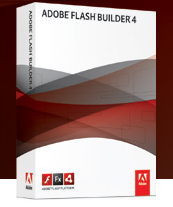 |
Adobe has released its new version of the Flex Builder, now renamed Flash Builder 4. This version is radically different from previous versions of Flex, introducing the new Spark architecture and theme support. While I’m pleased Adobe has finally added support for Eclipse 3.5, I’m disappointed with some of the new architecture changes that make doing simple things, such as skinning a button, now quite cumbersome. |
1. Spark and Halo: Duplicate Code will be Flex’s downfall
The Spark framework introduces a new set of UI components that sit on top of mx, and in many cases, duplicate the logic. For example, you can now define an old Halo button <mx:button/> alongside a new Spark button <s:button/>, both within the same component. I predict this duplication of code will lead to confusing and muddled codebases. Some developers will use all Spark components, some will use all Halo components, and some will use an inconsistent mix of the two.
The idea of two different components with the same name existing within the same application worries me greatly. It would be like Sun releasing a new version of the String class in Java 8, and rather than updating the old String class you now had 2 distinct classes to choose from, both called String, with the package name determining which you use. Sometimes reinventing the wheel is a sign the developers were too lazy to merge their changes into the existing wheel.
2. Broken Migration Paths
When I attempted to migrate some of my Flex 3 applications into Flash Builder 4, I received a number of compiler errors. The first thing I needed to do was right click on the project and change the Theme to Halo (Flex 3-based theme), since it defaults to Spark. This fixed many, but not all, of the compiler issues. After fixing the remaining compiler issues by hand, I ran the application only to discover none of my buttons had text on them! I enabled “Use Flash Text Engine in MX components” which fixed some, but not all, of the button text, but there were still dozens, possibly hundreds, of UI issues that caused the application to look awful. Realizing migrating the entire application into a native Flex 4 application would take endless amount of hours, I reviewed the compiler options again and checked the “Use Flex 3 compatibility mode” option, which, again, fixed some, but not all, of all the issues. Even with Flex 3 compatibility mode enabled, the compiler still handled the following components differently than it had in Flex 3: drag/drop pop-up images, recognizing css text-align property on certain components, and adding padding on some components. With the compatibility mode enabled, the number of issues was drastically reduced to a few dozen issues, but this was at the cost of limiting the new features available in Flex 4.
3. Skinning a button: 5 lines of code now take 51 lines of code
Previously, skinning a button was just a matter of defining some images in a CSS file and telling the application to use this style. It was intuitive, quite similar to HTML/CSS so it was easy to pick up, and only took a few lines of code, such as the following:
.myButton{
skin:Embed(source="/assets/menu.png");
overSkin:Embed(source="/assets/menu_over.png");
downSkin:Embed(source="/assets/menu_down.png");
}
Flex 4 now makes skinning extremely complicated. In order to accomplish the above example in Flex 4, you would need to define a custom skin class such as in the following example taken from here:
<?xml version="1.0" encoding="utf-8"?>
<!-- http://blog.flexexamples.com/2010/03/24/using-a-bitmap-image-skin-in-a-spark-button-control-in-flex-4/ -->
<s:SparkSkin name="ImageButtonSkin"
xmlns:fx="http://ns.adobe.com/mxml/2009"
xmlns:s="library://ns.adobe.com/flex/spark"
xmlns:fb="http://ns.adobe.com/flashbuilder/2009"
minWidth="21" minHeight="21"
alpha.disabled="0.5">
<!-- states -->
<s:states>
<s:State name="up" />
<s:State name="over" />
<s:State name="down" />
<s:State name="disabled" />
</s:states>
<!-- host component -->
<fx:Metadata>
[HostComponent("spark.components.Button")]
</fx:Metadata>
<fx:Script fb:purpose="styling">
<![CDATA[
/* Define the skin elements that should not be colorized.
For button, the graphics are colorized but the label is not. */
static private const exclusions:Array = ["labelDisplay"];
override public function get colorizeExclusions():Array {
return exclusions;
}
override protected function initializationComplete():void {
useChromeColor = true;
super.initializationComplete();
}
]]>
</fx:Script>
<s:BitmapImage source="@Embed('/assets/menu.png')"
source.over="@Embed('/assets/menu_over.png')"
source.down="@Embed('/assets/menu_down.png')"
left="0" right="0" top="0" bottom="0" />
<!-- layer 8: text -->
<s:Label id="labelDisplay"
textAlign="center"
verticalAlign="middle"
maxDisplayedLines="1"
horizontalCenter="0" verticalCenter="1"
left="10" right="10" top="2" bottom="2" />
</s:SparkSkin>
Talk about wasted space! I understand the power the new skin mechanism adds (you can now layer effects), but I personally don’t feel it’s worth it.
The future of Flex
Adobe has touted the power of Flash Builder 4, but as we have all seen in the past sometimes more powerful designs lead to failure. I think Adobe forgot the KISS principle, or perhaps they had one too many designers at the table instead of developers when they were creating the new architecture. While I liked the ease, power, and simple nature of Flex 3, I’m not convinced of the merits of Flash Builder 4 from a developer perspective. It seems like they made our job a lot more difficult and time consuming.
More articles to follow as I delve into the beast that is Flash Builder 4!



